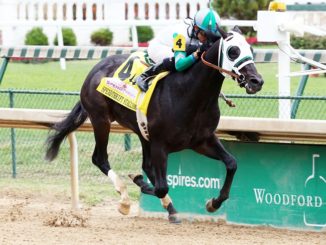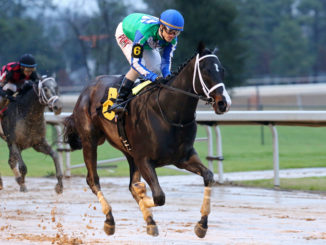
In a fitting tribute, Saturday’s $1 million Rebel (G2) at Oaklawn Park will be preceded on Friday’s card by the inaugural running of the $125,000 Temperence Hill for older horses over 1 1/2 miles, a distance so little used at Oaklawn that the standing track record dates to 1957.
Although Elocutionist had placed in the Rebel before going on to win the Preakness (G1) in 1976, it was Temperence Hill who arguably put Oaklawn’s second most prestigious 3-year-old event on the map 40 years ago this spring.
Described by trainer Joe Cantey as a “big, awkward, unathletic colt,” Temperence Hill was well beaten in three starts as a 2-year-old for owner John Ed Anthony’s Loblolly Stable. All were sprints in New York, including a career-opening loss to future leading sire Fappiano.
“We just backed off and gave him some more time to find himself…,” Cantey would later tell the Associated Press.
Reappearing at Oaklawn in the winter of 1980, Temperence Hill rallied from 11 lengths back to break his maiden going 6 furlongs and then, one week later, was up in time to win an allowance in his first two-turn attempt.
Eleven days after the allowance victory, Temperence Hill was one of 15 horses entered in the Rebel, which at the time carried a gross purse of $64,000, the equivalent of nearly $200,000 today. Sam Maple, who had ridden Temperence Hill to both overnight wins, chose to ride another horse and was replaced by Darrell Haire.
“I didn’t want Darrell to rush him the first part of the race,” said Cantey, who watched Temperence Hill drop 17 lengths off the pace early. But the son of Stop the Music began making up considerable ground around the far turn chasing a brisk pace of :22 and :45 2/5.
“(Haire) wheeled him outside and it looked like heading for home, he had a heckuva shot,” Cantey said. Four lengths down with a furlong remaining, Temperence Hill motored home to a 2 1/4-length victory and paid $35.
“I don’t normally get this way about many horses, but I’m a little bit excited about this colt,” Cantey said. “He ran a big race. He came from so far back and he did it fairly within himself.”
Temperence Hill proved an iron horse at Oaklawn that spring, making his fourth start of the meet in an allowance 10 days after the Rebel. Second that day to Loto Canada, whom Sam Maple had chosen to ride in the Rebel, Temperence Hill was back on top of that rival and others two weeks later in the Arkansas Derby (G2), winning the nine-furlong test by 1 1/4 lengths after dropping 18 lengths off the pace.
Unfortunately, Temperence Hill’s participation in the Kentucky Derby (G1) had long been a moot point as he was not nominated to the first classic. He was still a maiden when nominations for the Derby had closed in mid-February, and at the time there was no supplementary process.
“It’s tough to go around nominating every maiden in your barn to the Kentucky Derby,” Cantey had said after the Rebel.
Temperence Hill was supplemented, however, to the Belmont S. (G1) for a fee of $20,000. After running second in the Withers (G2), a dull fifth as an odds-on favorite in the Pennsylvania Derby (G3), and third in a turf allowance all in the span of three weeks in May, Temperence Hill went to post as a 53-1 longshot in the “Test of the Champion.” Among his rivals were Preakness (G1) winner Codex, Derby-winning filly Genuine Risk, and Derby runner-up Rumbo.
“All week people thought we were crazy because we said he had a chance,” said Charlsie Cantey, Joe’s then-wife and a prominent racing broadcaster, to The New York Times.
Thriving in the mud and over the extended 1 1/2 miles, Temperence Hill circled the field at the top of the stretch and wore down a game Genuine Risk to win by two lengths with Eddie Maple aboard.
Temperence Hill remained busy the rest of 1980, turning in 17 starts in total that season. Although flopping against older rivals in the Brooklyn H. (G1) and Marlboro Cup (G1), and in a pair of grass stakes, Temperence Hill racked up additional wins in the Travers (G1), the 1 1/2-mile Jockey Club Gold Cup (G1), and the inaugural Super Derby. The Gold Cup and Super Derby were the two richest races in the country that season.
Temperence Hill was voted champion 3-year-old colt of 1980, and returned to Oaklawn the following spring and won the Razorback H. (G2) and Oaklawn H. (G2). After winning the Suburban H. (G1) at Belmont in July, Temperence Hill went unplaced in four of his final five stakes appearances.
One of five Rebel winners to sport the chocolate and yellow Loblolly (now Shortleaf Stable) silks, Temperence Hill died in the summer of 2013 at a farm near Bangkok, Thailand, after previously standing at Gainesway Farm in Kentucky and at several farms in Arkansas.



